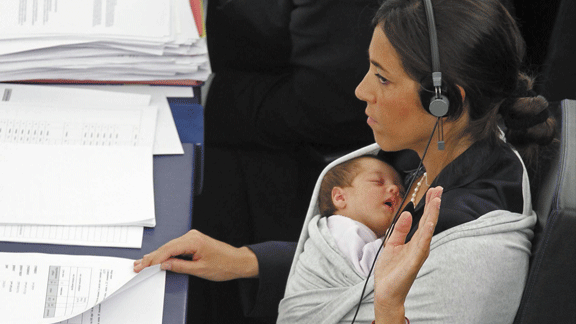Parental leave, family taxes and social control

The 2015 budget has significant ramifications for women and families.
The most publicised aspect of the proposed changes has been the crackdown on so-called double dipping in relation to paid parental leave. Despite the public scheme being established in 2010 with the explicit purpose of complementing private entitlements, the government intends to limit women’s access to only one from July 2016.
After initially declaring that a more generous maternity leave scheme was “signature” policy, the government is now seeking to demonise women who dare to make use of their leave entitlements to spend the maximum possible time with a new baby.
In relation to family tax benefits and childcare arrangements, the government’s budget proposals are lifted from the 2014 Commission of Audit. They include drastically reducing the availability of Family Tax Benefit B by limiting it to parents of children under 6 rather than up to 16, freezing indexation of both family payments, scrapping or reducing the extra subsidies for multiple births and large families, and introducing a subsidy scheme for child care, including in-home services (nannies).
Despite the government’s spin that this represents a boon for families, these changes in fact involve slashing welfare payments and limiting the choices available to women in order to advance the government’s social and economic agenda.
In contrast to the Howard era, during which single income households with women caring full time for children were rewarded while working mothers were disadvantaged, the emphasis today is on encouraging or coercing women to remain in the workforce rather than take time out to care for children.
This has nothing to do with empowering women and everything to do with eroding the welfare state and boosting the corporate sector.
It will involve a significant transfer in public spending away from payments that support households with children and towards business. The Australian Council of Social Services estimates that these changes will strip more than $15 billion from families and lower income households over the next five years, with much of it being channelled to private, for-profit childcare providers.
By depriving women of adequate income support, the proposed measures not only deny women the right to spend time with children if that is their preference, but also force them into the workforce or an already overstrained job market. Because there are far more job seekers than there are jobs in the Australian economy, many of these women will simply deepen the pool of unemployed who are forced to take low paid jobs with poor conditions.
At the same time, the government’s proposed childcare subsidy is really a handout to business and the rich. Rather than paying the subsidy directly to parents, as has been the case in previous schemes – or providing publicly funded child care – the government will give money directly to private childcare businesses.
The nanny scheme reflects the same class prejudice: it is a thinly disguised gift to the wealthiest parents, households with incomes up to $250,000 a year qualifying for it. Compare this to the threshold at which Family Tax Benefit A cuts out entirely – $112,000 – and the target recipients of this policy are clear.
So, while it’s been a historic gain for women that the right to work after marriage and childbirth has been established, government schemes that compel women to stay in work in order to transfer public money from welfare to corporate handouts have nothing to do with advancing the position of women.
For women to have real freedom and control over their lives, social services and economic assistance must be made available in order that they may contribute to society however they choose – without being economically disadvantaged or forced to rely for financial support on partners or other family.
This means paid maternity leave for as long as is required, working conditions that accommodate parental responsibilities and also guarantee job security and social support to help with the cost of children and child care – support that is free, properly staffed and available 24 hours a day. For this to be achieved, it will take an enormous struggle, a struggle that will be impossible without workers’ organisation and union strength being rebuilt.